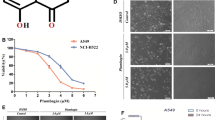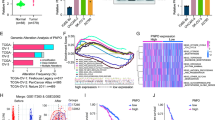Abstract
Pancreatic cancer has a 5-year survival rate below 10% and the treatment options are limited. Signal transducer and activator of transcription (STAT3) is a constitutively expressed protein in human pancreatic cancers and is associated with their poor prognosis. Targeting of STAT3 signaling using novel therapeutic agents is a potential strategy for pancreatic cancer treatment. Diarylidenylpiperidone (DAP) compounds, such as H-4073 and HO-3867, have been shown to be STAT3 inhibitors in several human ovarian cancers. Particularly, HO-3867 is an N-hydroxypyrroline derivative of DAP that has targeted cytotoxicity toward cancer cells without affecting healthy cells. In the present study, we evaluated the anticancer efficacy of H-4073 and HO-3867 in a human pancreatic cell line (AsPC-1). We found that both the compounds exhibited potential cytotoxicity to AsPC-1 cells by inducing G2/M cell-cycle arrest, apoptosis, and cell death, by mitochondrial damage and inhibition of STAT3 phosphorylation. In summary, H-4073 and HO-3867 are cytotoxic to AsPC-1 cells and seem to act through similar mechanisms, including STAT3 inhibition, cell-cycle arrest, and apoptosis.







Similar content being viewed by others
References
SEER, N. Cancer Stat Facts: Pancreatic Cancer. 2015. https://seer.cancer.gov/statfacts/html/pancreas.html.
Society, A.C. About Pancreatic Cancer. 2019 https://www.cancer.org/content/dam/CRC/PDF/Public/8778.00.pdf. Accessed 11 Feb 2019.
Spadi, R., Brusa, F., Ponzetti, A., Chiappino, I., Birocco, N., Ciuffreda, L., Satolli, M. A. (2016). Current therapeutic strategies for advanced pancreatic cancer: a review for clinicians. World J Clin Oncol, 7(1), 27–43.
Vaziri-Gohar, A., Zarei, M., Brody, J. R., Winter, J. M. (2018). Metabolic dependencies in pancreatic cancer. Front Oncol, 8, 617.
Reynolds, R. B., Folloder, J. (2014). Clinical management of pancreatic cancer. J Adv Pract Oncol, 5(5), 356–364.
Yuen, A., & Diaz, B. (2014). The impact of hypoxia in pancreatic cancer invasion and metastasis. Hypoxia (Auckl), 2, 91–106.
Wu, P., Wu, D., Zhao, L., Huang, L., Shen, G., Huang, J., Chai, Y. (2016). Prognostic role of STAT3 in solid tumors: a systematic review and meta-analysis. Oncotarget, 7(15), 19863–19883.
Gray, M. J., Zhang, J., Ellis, L. M., Semenza, G. L., Evans, D. B., Watowich, S. S., Gallick, G. E. (2005). HIF-1alpha, STAT3, CBP/p300 and Ref-1/APE are components of a transcriptional complex that regulates Src-dependent hypoxia-induced expression of VEGF in pancreatic and prostate carcinomas. Oncogene, 24(19), 3110–3120.
Wu, X., Tang, W., Marquez, R. T., Li, K., Highfill, C. A., He, F., Lian, J., Lin, J., Fuchs, J. R., Ji, M., Li, L., Xu, L. (2016). Overcoming chemo/radio-resistance of pancreatic cancer by inhibiting STAT3 signaling. Oncotarget, 7(10), 11708–11723.
ElNaggar, A. C., Saini, U., Naidu, S., Wanner, R., Sudhakar, M., Fowler, J., Nagane, M., Kuppusamy, P., Cohn, D. E., Selvendiran, K. (2016). Anticancer potential of diarylidenyl piperidone derivatives, HO-4200 and H-4318, in cisplatin resistant primary ovarian cancer. Cancer Biol Ther, 17(10), 1107–1115.
Selvendiran, K., Ahmed, S., Dayton, A., Kuppusamy, M. L., Tazi, M., Bratasz, A., Tong, L., Rivera, B. K., Kalai, T., Hideg, K., Kuppusamy, P. (2010). Safe and targeted anticancer efficacy of a novel class of antioxidant-conjugated difluorodiarylidenyl piperidones: differential cytotoxicity in healthy and cancer cells. Free Radic Biol Med, 48(9), 1228–1235.
Selvendiran, K., Tong, L., Bratasz, A., Kuppusamy, M. L., Ahmed, S., Ravi, Y., Trigg, N. J., Rivera, B. K., Kalai, T., Hideg, K., Kuppusamy, P. (2010). Anticancer efficacy of a difluorodiarylidenyl piperidone (HO-3867) in human ovarian cancer cells and tumor xenografts. Mol Cancer Ther, 9(5), 1169–1179.
Weir, N. M., Selvendiran, K., Kutala, V. K., Tong, L., Vishwanath, S., Rajaram, M., Tridandapani, S., Anant, S., Kuppusamy, P. (2007). Curcumin induces G2/M arrest and apoptosis in cisplatin-resistant human ovarian cancer cells by modulating Akt and p38 MAPK. Cancer Biol Ther, 6(2), 178–184.
Kalai, T., Kuppusamy, M. L., Balog, M., Selvendiran, K., Rivera, B. K., Kuppusamy, P., Hideg, K. (2011). Synthesis of N-substituted 3,5-bis(arylidene)-4-piperidones with high antitumor and antioxidant activity. J Med Chem, 54(15), 5414–5421.
Dayton, A., Selvendiran, K., Meduru, S., Khan, M., Kuppusamy, M. L., Naidu, S., Kalai, T., Hideg, K., Kuppusamy, P. (2011). Amelioration of doxorubicin-induced cardiotoxicity by an anticancer-antioxidant dual-function compound, HO-3867. J Pharmacol Exp Ther, 339(2), 350–357.
Rath, K. S., Naidu, S. K., Lata, P., Bid, H. K., Rivera, B. K., McCann, G. A., Tierney, B. J., Elnaggar, A. C., Bravo, V., Leone, G., Houghton, P., Hideg, K., Kuppusamy, P., Cohn, D. E., Selvendiran, K. (2014). HO-3867, a safe STAT3 inhibitor, is selectively cytotoxic to ovarian cancer. Cancer Res, 74(8), 2316–2327.
Madan, E., Parker, T. M., Bauer, M. R., Dhiman, A., Pelham, C. J., Nagane, M., Kuppusamy, M. L., Holmes, M., Holmes, T. R., Shaik, K., Shee, K., Kiparoidze, S., Smith, S. D., Park, Y. A., Gomm, J. J., Jones, L. J., Tomas, A. R., Cunha, A. C., Selvendiran, K., Hansen, L. A., Fersht, A. R., Hideg, K., Gogna, R., Kuppusamy, P. (2018). The curcumin analog HO-3867 selectively kills cancer cells by converting mutant p53 protein to transcriptionally active wildtype p53. J Biol Chem, 293(12), 4262–4276.
Matsumoto, S., Kishimoto, S., Saito, K., Takakusagi, Y., Munasinghe, J. P., Devasahayam, N., Hart, C. P., Gillies, R. J., Mitchell, J. B., Krishna, M. C. (2018). Metabolic and physiologic imaging biomarkers of the tumor microenvironment predict treatment outcome with radiation or a hypoxia-activated prodrug in mice. Cancer Res, 78(14), 3783–3792.
Selvendiran, K., Ahmed, S., Dayton, A., Ravi, Y., Kuppusamy, M. L., Bratasz, A., Rivera, B. K., Kalai, T., Hideg, K., Kuppusamy, P. (2010). HO-3867, a synthetic compound, inhibits the migration and invasion of ovarian carcinoma cells through downregulation of fatty acid synthase and focal adhesion kinase. Mol Cancer Res, 8(9), 1188–1197.
Selvendiran, K., Ahmed, S., Dayton, A., Kuppusamy, M. L., Rivera, B. K., Kalai, T., Hideg, K., Kuppusamy, P. (2011). HO-3867, a curcumin analog, sensitizes cisplatin-resistant ovarian carcinoma, leading to therapeutic synergy through STAT3 inhibition. Cancer Biol Ther, 12(9), 837–845.
Dayton, A., Selvendiran, K., Kuppusamy, M. L., Rivera, B. K., Meduru, S., Kalai, T., Hideg, K., Kuppusamy, P. (2010). Cellular uptake, retention and bioabsorption of HO-3867, a fluorinated curcumin analog with potential antitumor properties. Cancer Biol Ther, 10(10), 1027–1032.
Dimmock, J. R., Padmanilayam, M. P., Puthucode, R. N., Nazarali, A. J., Motaganahalli, N. L., Zello, G. A., Quail, J. W., Oloo, E. O., Kraatz, H. B., Prisciak, J. S., Allen, T. M., Santos, C. L., Balzarini, J., De Clercq, E., Manavathu, E. K. (2001). A conformational and structure-activity relationship study of cytotoxic 3,5-bis(arylidene)-4-piperidones and related N-acryloyl analogues. J Med Chem, 44(4), 586–593.
Prabhat, A. M., Kuppusamy, M. L., Bognar, B., Kalai, T., Hideg, K., Kuppusamy, P. (2019). Antiproliferative effect of a novel 4,4’-disulfonyldiarylidenyl piperidone in human colon cancer cells. Cell Biochem Biophys, 77(1), 61–67.
Adams, B. K., Cai, J., Armstrong, J., Herold, M., Lu, Y. J., Sun, A., Snyder, J. P., Liotta, D. C., Jones, D. P., Shoji, M. (2005). EF24, a novel synthetic curcumin analog, induces apoptosis in cancer cells via a redox-dependent mechanism. Anticancer Drugs, 16(3), 263–275.
Selvendiran, K., Tong, L., Vishwanath, S., Bratasz, A., Trigg, N. J., Kutala, V. K., Hideg, K., Kuppusamy, P. (2007). EF24 induces G2/M arrest and apoptosis in cisplatin-resistant human ovarian cancer cells by increasing PTEN expression. J Biol Chem, 282(39), 28609–28618.
Krishna, M. C., Grahame, D. A., Samuni, A., Mitchell, J. B., Russo, A. (1992). Oxoammonium cation intermediate in the nitroxide-catalyzed dismutation of superoxide. Proc Natl Acad Sci USA, 89(12), 5537–5541.
Krishna, M. C., Russo, A., Mitchell, J. B., Goldstein, S., Dafni, H., Samuni, A. (1996). Do nitroxide antioxidants act as scavengers of O2-. or as SOD mimics? J Biol Chem, 271(42), 26026–26031.
Cheng, G., Zielonka, J., Ouari, O., Lopez, M., McAllister, D., Boyle, K., Barrios, C. S., Weber, J. J., Johnson, B. D., Hardy, M., Dwinell, M. B., Kalyanaraman, B. (2016). Mitochondria-targeted analogues of metformin exhibit enhanced antiproliferative and radiosensitizing effects in pancreatic cancer cells. Cancer Res, 76(13), 3904–3915.
Kalyanaraman, B., Cheng, G., Hardy, M., Ouari, O., Sikora, A., Zielonka, J., Dwinell, M. B. (2017). Modified metformin as a more potent anticancer drug: mitochondrial inhibition, redox signaling, antiproliferative effects and future EPR studies. Cell Biochem Biophys, 75(3-4), 311–317.
Kumar, B., Yadav, A., Hideg, K., Kuppusamy, P., Teknos, T. N., Kumar, P. (2014). A novel curcumin analog (H-4073) enhances the therapeutic efficacy of cisplatin treatment in head and neck cancer. PLoS ONE, 9(3), e93208.
Rath, K. S., McCann, G. A., Cohn, D. E., Rivera, B. K., Kuppusamy, P., Selvendiran, K. (2013). Safe and targeted anticancer therapy for ovarian cancer using a novel class of curcumin analogs. J Ovarian Res, 6(1), 35.
Subramaniam, D., May, R., Sureban, S. M., Lee, K. B., George, R., Kuppusamy, P., Ramanujam, R. P., Hideg, K., Dieckgraefe, B. K., Houchen, C. W., Anant, S. (2008). Diphenyl difluoroketone: a curcumin derivative with potent in vivo anticancer activity. Cancer Res, 68(6), 1962–1969.
He, G., Feng, C., Vinothkumar, R., Chen, W., Dai, X., Chen, X., Ye, Q., Qiu, C., Zhou, H., Wang, Y., Liang, G., Xie, Y., Wu, W. (2016). Curcumin analog EF24 induces apoptosis via ROS-dependent mitochondrial dysfunction in human colorectal cancer cells. Cancer Chemother Pharmacol, 78(6), 1151–1161.
Krishna, M. C., & Samuni, A. (1994). Nitroxides as antioxidants. Methods Enzymol, 234, 580–589.
Acknowledgements
This work was supported by Hungarian Research Fund Grant OTKA FK 124331 and GINOP 2.3.2-15-2016-00049.
Author information
Authors and Affiliations
Corresponding author
Ethics declarations
Conflict of Interest
The authors declare that they have no conflict of interest.
Additional information
Publisher’s note: Springer Nature remains neutral with regard to jurisdictional claims in published maps and institutional affiliations.
Rights and permissions
About this article
Cite this article
Mast, J.M., Tse, D., Shee, K. et al. Diarylidenylpiperidones, H-4073 and HO-3867, Induce G2/M Cell-Cycle Arrest, Apoptosis and Inhibit STAT3 Phosphorylation in Human Pancreatic Cancer Cells. Cell Biochem Biophys 77, 109–119 (2019). https://doi.org/10.1007/s12013-019-00873-6
Received:
Accepted:
Published:
Issue Date:
DOI: https://doi.org/10.1007/s12013-019-00873-6




